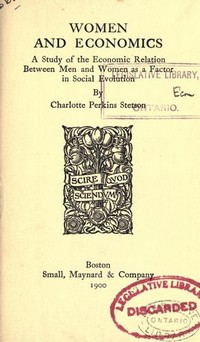Women and Economics
 |
|
| Author | Charlotte Perkins Gilman |
|---|---|
| Country | United States |
| Language | English |
| Publisher | Small, Maynard & Company, et al |
|
Publication date
|
1898 |
| Pages | 389 |
Women and Economics – A Study of the Economic Relation Between Men and Women as a Factor in Social Evolution is a book written by Charlotte Perkins Gilman and published in 1898. It is considered by many to be her single greatest work, and as with much of Gilman’s writing, the book touched a few dominant themes: the transformation of marriage, the family, and the home, with her central argument: “the economic independence and specialization of women as essential to the improvement of marriage, motherhood, domestic industry, and racial improvement.”
The 1890s were a period of intense political debate and economic challenges, with the Women’s Movement seeking the vote and other reforms. Women were “entering the work force in swelling numbers, seeking new opportunities, and shaping new definitions of themselves.” It was near the end of this tumultuous decade that Gilman’s very popular book emerged.
Centrally, Gilman argues that women must change their cultural identities. Early on, she mentions that humans are the only species in which the female has to depend on the male for survival. This dependence requires women to pay off their debt through domestic services, or “sex-functions”. Gilman argues that women “work longer and harder than most men, and not solely in maternal duties.” Further, Gilman states that female activities in general are directed by men. These sexual distinctions have led to an odd distribution of power and have been detrimental to both genders, in Gilman’s view.
These sexual distinctions have left women behind and allowed men to claim credit for human progress. Gilman argues that women fulfill the dual roles of mother and martyr, and pass these roles down to their children, creating a continuing image of women as unpaid workers and nurturers. This in turn, has stunted women’s creative and personal growth.
Gilman was a confirmed suffragist, but did not believe progress would happen if women were only given the vote. Progress was not measured only by states that allowed women to vote, but as well “in the changes legal, social, mental and physical, which mark the advance of the mother of the world toward her full place.”
Gilman also reflects on the strange fact that poorer women who can least afford it, have more children, while wealthy women who can afford it, have fewer children. Gilman talks about the agricultural age, when more children were needed to assist with farming. In the industrial age however, more children result in more work for the mother. Gilman argued all these points, but still believed motherhood was “the common duty and the common glory of womanhood,” and women would choose “professions compatible with motherhood."
Along with being nurturers, Gilman argues that women are also required to be educators. There is no proof in Gilman’s opinion however, that women who sacrifice to be nurturers and educators will produce better children. Gilman believes that others can assist with these tasks or even do them more effectively. Gilman was one of the first to propose the professionalization of housework, encouraging women to hire housekeepers and cooks to release them from housework. Gilman envisioned kitchenless houses and designed cooperative kitchens in city apartment buildings which would further help women balance work and family and provide some social support for wives who were still homebound. This would allow women to participate in the workforce and lead a more worldly life. Gilman believed that women could desire home and family life, but should not have to retain complete responsibility of these areas. Gilman stated that these changes would eventually result in “better motherhood and fatherhood, better babyhood and childhood, better food, better homes, better society.”
...
Wikipedia
